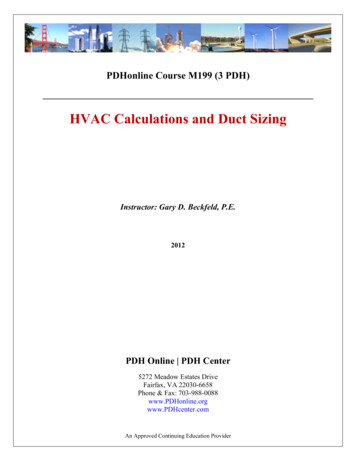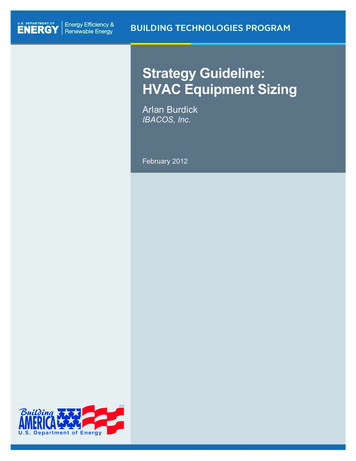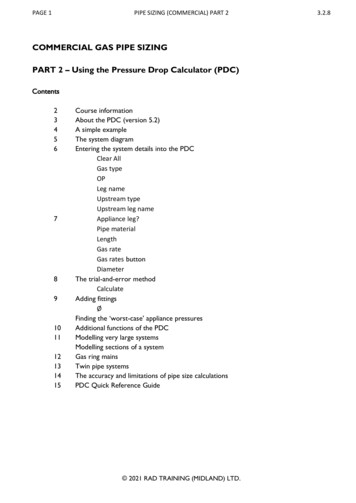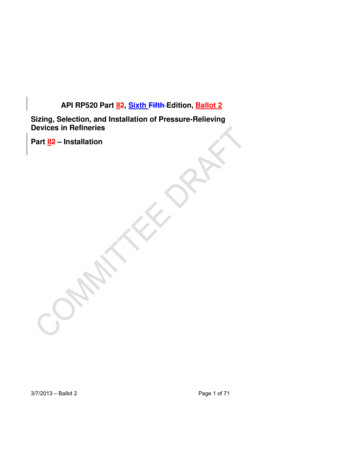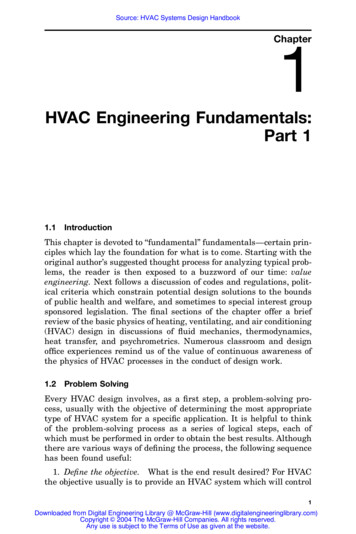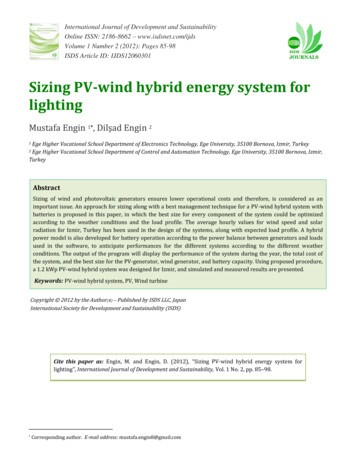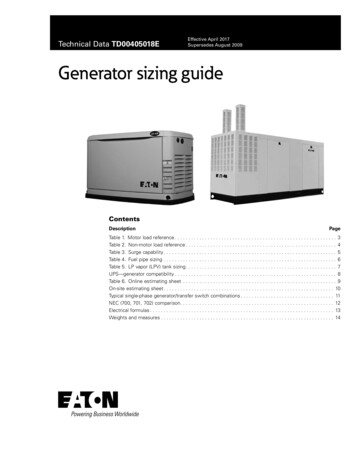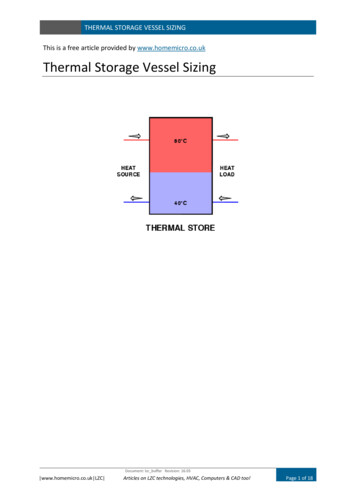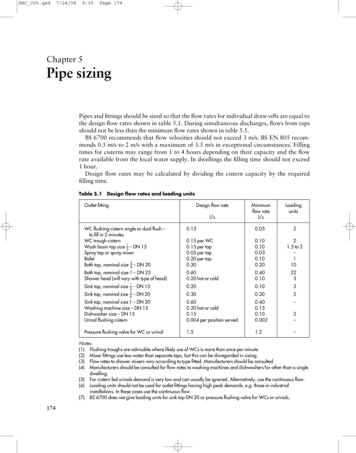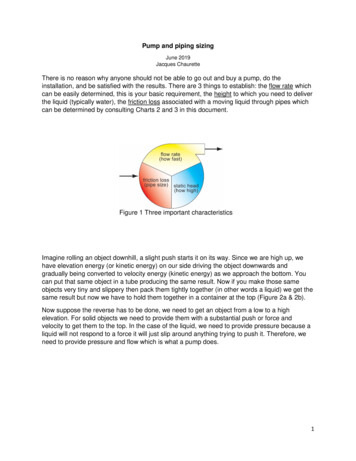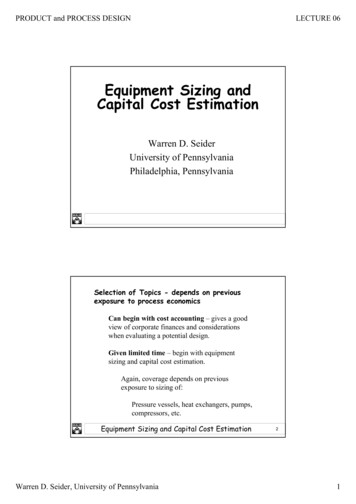
Transcription
Introductionto BuildingAmericaBuilding TechnologiesProgramHVAC Right-Sizing Part 1:Calculating LoadsThursday, April 2811:00 a.m. - 12:00 p.m. EasternPresented by:Mike Gestwick - National RenewableEnergy LaboratoryArlan Burdick, Anthony Grisolia – IBACOS, aBuilding America Research Team
Building America: IntroductionMike GestwickApril 28, 2011michael.gestwick@nrel.gov
Introduction to Building America Reduce energy use in new and existing residential buildings Promote building science and systems engineering /integration approach “Do no harm”: Ensure safety, health and durability aremaintained or improved Accelerate adoption of high performance technologieswww.buildingamerica.gov
15 Industry Research TeamsAlliance for Residential Building Innovation (ARBI)NorthernSTAR Building America PartnershipBuilding America Retrofit Alliance (BARA)Habitat Cost Effective Energy Retrofit ProgramBuilding Energy Efficient Homes for America (BeeHa)
About Our Speakers Building Performance Specialist Bachelors in Mechanical EngineeringTechnology LEED Accredited ProfessionalArlanArlan Formerly worked for a large-scale productionhomebuilding company IBACOS Services Manager Helps builders create construction standards Evaluates construction quality and comfortissuesAnthony Performs quality assessments
About Today’s SessionThe BIG PICTURE – Why Care?3 Key Factors for Calculating Loads1Design Considerations (15-18 min.)2The Thermal Enclosure (10 min.)3Internal Loads (5 min.)What Happens When You “Fudge” the Numbers?Put your presentation title or confidentiality info here
Q&A: How to Participate NEED INFO/SCREEN CAP FROM WINDOWS LIVEType question in this box, select “Ask”MEETING– theWILLGET THIS FROM TUESDAY’S(not the symbol ofraised handPRACTICE SESSIONPut your presentation title or confidentiality info here
Webinar PollPut your presentation title or confidentiality info here
The BIG Picture
What is HVAC supposed to do? Keep the occupants of a homemore comfortable by– Adjusting internal temperatures– Mixing air in rooms– Maintaining humidity levels Operate unnoticed Be energy efficientPut your presentation title or confidentiality info here
Big Picture: New construction –15% less energyeach code cycle Existing homes –Homeownersupdating withinsulation, windowsand moreMarket DemandPut your presentation title or confidentiality info here
Big Picture:Simplistic Design ApproachHVAC Sizing ChartInstructions1.Print this page.2.Carefully cut outthe holes.3.Stand on curb acrossthe street and holdpage 1 foot from yourface.4.Find the hole that’s theclosest match.5.Size HVAC accordinglyPut your presentation title or confidentiality info here
Big Picture:Just to be safe How manyfingers do youput on the scale?ACCA says NONE.Experience bearsthis out.Put your presentation title or confidentiality info here
Big Picture:Why is right-sizing so important?Enclosures are ImprovingRules of Thumb Haven’t Rooms have much lower loads More moisture is retained Less infiltration –or “natural ventilation”Put your presentation title or confidentiality info here
Big Picture:Best Practice for Right-Sizing HVACIterative Process1. Load calculations2. Equipment selectionand sizing3. Duct and registersizingPut your presentation title or confidentiality info here
Big Picture:What Is the Load? The measure of energy the HVAC system needs toadd or remove from a space to provide the desiredlevel of comfort– Btu/h Not the size of the HVAC system– First piece of information needed– 12,000 Btu/h 1 Ton Cooling Can be highly variablePut your presentation title or confidentiality info here
Big Picture:Heating Loads Losses to theoutsideenvironment No credit is takenfor solar gains orinternal loadsbecause the peakheat loss occurs atnight during periodsof occupantinactivityPut your presentation title or confidentiality info here
Big Picture:Cooling Loads Gains from theoutsideenvironment Solar Gains Internal Gains Sensible and LatentComponentsPut your presentation title or confidentiality info here
Big Picture:How to Approach Manual J Designer should– Walk a house in production– Look at plans– Ask for all specifications Builder doesn’t have the info?Get the homes tested!– Duct leakage– Air tightnessPut your presentation title or confidentiality info here
Big Picture:Importance of Getting It RightHVAC DesignImpacts 1st construction costs Comfort Indoor air quality Building durability Energy efficiency Higher customersatisfaction/lower call backsPut your presentation title or confidentiality info here
Key Factor #1:Design Considerations
Design Considerations Location of the House Size of the House Indoor Design ConditionsPut your presentation title or confidentiality info here
Design Considerations:Location of the House Latitude Elevation Outdoortemperature andrelative humiditySource: ACCA Manual J Version 8, Table 1APut your presentation title or confidentiality info here
Design Considerations:Location of the HouseOrientationThe orientation of thehouse must beconsidered in thecooling loadcalculation due tochanging solar heatgains at various timesof the day.Put your presentation title or confidentiality info here
Design Considerations:Best Case East36,000 Btu/hLocation of the HouseWorst Case North West41,000 Btu/h5,000 Btu/h differencePut your presentation title or confidentiality info here
Design Considerations:Size of the House Square footage Volume Number ofbedroomsPut your presentation title or confidentiality info here
Design Considerations:Indoor Design Conditions Indoortemperature RelativehumidityCooling Season 75 F, 50% RHHeating Season 70 F, 30% RHSource: MJ8ASHRAEComfort ZoneChartPutandyourpresentationtitleor confidentiality info here
Fudge Factor #1What happens when you fudgeheating and cooling set points?Put your presentation title or confidentiality info here
Fudge Factor #1Fudging setpoints 10,400Btu/h additionalcooling load,potentiallyover-sizing thecooling systemby 1 tonPut your presentation title or confidentiality info here
Webinar PollPut your presentation title or confidentiality info here
Questions?Put your presentation title or confidentiality info here
Key Factor #2:Thermal Enclosure
Evolution with Code ChangesIECC 2009IECC 2006Ductwork6%Code on17%Opaque k0%Windows29%Put your presentation title or confidentiality info here
Enclosure:Key Factors to Consider Insulation values Window specification Air tightness External and internal shadingPut your presentation title or confidentiality info here
Enclosure:Insulation Values Walls Ceilings FloorsPut your presentation title or confidentiality info here
Enclosure:WindowsPut your presentation title or confidentiality info here
Enclosure:Windows Orientation Size Thermalconductivity Solar Heat GainCoefficient (SHGC)Put your presentation title or confidentiality info here
Enclosure:Windows12,000Impact of WindowSpecification onPeak Cooling Load U 0.35 SHGC 0.30 versus U 0.28SHGC 0.26 When buildings arewell insulated andair sealed windowsare more U 0.35,SHGC 0.30 WestU 0.35,SHGC 0.30 - Back ofHouse Facing WestU 0.28,SHGC 0.26 WestU 0.28,SHGC 0.26 - Back ofHouse Facing WestU 0.35,SHGC 0.30 - 0014:0015:0016:0017:00Put your presentation title or confidentiality info here18:0019:0020:00
Enclosure:Air TightnessThe target ventilationand infiltration ratemust be accuratelyrepresented in the datainputIn humid climates, theimpact on the latentcooling load can besignificant.Put your presentation title or confidentiality info here
Enclosure:Air TightnessBlower Door is aCritical ToolHVAC contractorsneed proofPut your presentation title or confidentiality info here
Enclosure:Internal and External ShadingPut your presentation title or confidentiality info here
Questions?Put your presentation title or confidentiality info here
Key Factor #3:Internal Loads
Internal Loads # of occupants Electronics Lighting AppliancesPut your presentation title or confidentiality info here
Internal Loads System location Ductwork‒ Location‒ Insulation value‒ LeakagePut your presentation title or confidentiality info here
What Happens When You “Fudge” the Numbers?Intentional oraccidentalmanipulation of thedesign parameters canlead to large variationsin the loadPut your presentation title or confidentiality info here
Case Study: Examples of Numbers Gone Wrong Two Climate Zones– CZ2 Orlando FL– CZ5 Chicago IL Two Houses– 2223 ft2 slab-on-grade– 2223 ft2 on full basement Multiple runs through WrightSoft withcommon errors/safety factors– Altered outdoor/indoor design conditions– De-rated insulation, window performance,shading characteristics– Exaggerated infiltration and ventilation– Combined all safety factors for a grosslyexaggerated loadPut your presentation title or confidentiality info here
Fudge Factor #1 – Design ConditionsPut your presentation title or confidentiality info here
Fudge Factor #2 – Manipulating Thermal Enclosure DesignPut your presentation title or confidentiality info here
Fudge Factor #2 – Manipulating Thermal Enclosure DesignPut your presentation title or confidentiality info here
Fudge Factor #2 – Manipulating Thermal Enclosure Design 4,600 Btu/hHeating 5,600 Btu/hTotal CoolingPut your presentation title or confidentiality info here
Fudge Factor #3 – Ductwork ConditionsPut your presentation title or confidentiality info here
Fudge Factor #3 – Ductwork Conditions 3,500 Btu/hTotal coolingPut your presentation title or confidentiality info here
Fudge Factor #4 – Ventilation / Air InfiltrationPut your presentation title or confidentiality info here
Fudge Factor #4 – Ventilation / Air Infiltration 1,900 Btu/h Total coolingbut 1,100 of that is LatentPut your presentation title or confidentiality info here
Combined “Safety Factors” - ChicagoPut your presentation title or confidentiality info here
Combined “Safety Factors” - OrlandoPut your presentation title or confidentiality info here
Questions?Put your presentation title or confidentiality info here
Wrap Up
Resources IBACOS – Building America “Guide to Heating and CoolingLoad Calculations for High Performance Homes” Air Conditioning Contractors of America –Manual J Residential Load Calculation Eighth EditionPut your presentation title or confidentiality info here
Big Picture:We Just Covered Step 1 of 3Iterative Process1. Load calculations2. Equipment selectionand sizing3. Duct and registersizingPut your presentation title or confidentiality info here
Builder MembersBeazer HomesCharter HomesCobblestone HomesDarling HomesDominion HomesDoucette CommunitiesDSLD Homese-co labEQA CommunitiesHarvard CommunitiesHighland HomesHistory Maker HomesHubbell HomesImagine HomesInsight HomesK. HovnanianKB HomeKeystone Custom HomesLandmark RenovationMeritage HomesMistick ConstructionOrleans HomesPine Mountain BuildersPulte HomesRichmond AmericanS&A HomesShea Homesstudio26 homesTindall HomesVeridian HomesWathen-CastanosWayne HomesWinchester HomesSupported by:Put your presentation title or confidentiality info here
Thank you for joining us!More Questions?Arlan BurdickBuilding Performance Specialist406-548-7472aburdick@ibacos.comAnthony GrisoliaServices Manager412-915-4061agrisolia@ibacos.comInterested in Innovation? Join thewww.theresearchalliance.orgPut your presentation title or confidentiality info here
Building Technologies ProgramThank you for attending the webinarIf you have any comments or ideas for future webinars, please emailwebmasterbtp@nrel.govVisit www.buildings.energy.gov/webinars.html to downloadtoday’s presentation and to register for announcements of upcoming webinars.Building Technologies Programeere.energy.gov
Why is right- sizing so important? Put your presentation title or confidentiality info here. Big Picture: Iterative Process. 1. Load calculations 2. Equipment selection and sizing 3. Duct and register sizing. Best Practice for Right- Sizing HVAC. Put your presentation title or confidentiality info here . Big Picture: The measure of energy the HVAC system needs to add or remove from a space
